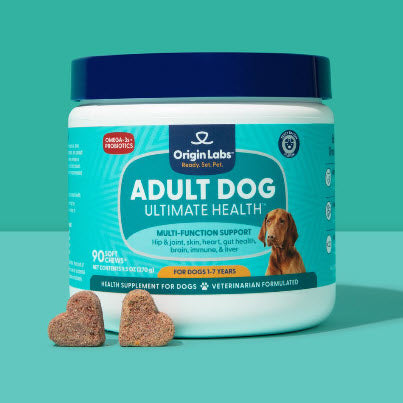1. Introduction
Feeding Asian pears to dogs is a topic many pet owners may find intriguing. Can dogs eat Asian pears? The short answer is yes, but it's important to understand the nuances involved.
Key Takeaways:
- Moderation is Key: Asian pears are generally safe for dogs when given in moderation.
- Important Factors: There are several considerations to keep in mind, such as portion size and potential risks.
For those interested in broader support for their pets, products like Ultimate Health chews for puppies and Ultimate Health chews for adult dogs offer tailored solutions to meet the specific needs of dogs at different life stages. These supplements are specially formulated to provide the necessary health support as your dog grows, whether they are a puppy or an adult dog.
2. The Nutritional Value of Asian Pears for Dogs
Understanding the Nutritional Composition of Asian Pears
Asian pears, often referred to as nashi or apple pears, offer a unique blend of nutrients that can be beneficial for dogs when consumed in moderation. These fruits are packed with essential vitamins and minerals, making them a healthy snack option.
Key nutritional components of Asian pears include:
- Fiber: Aids digestive health
- Vitamins A and C: Supports various aspects of wellbeing
- Potassium: Maintains proper cellular function
Fiber: Essential for Digestive Health
One of the standout features of Asian pears is their high fiber content. Fiber plays a crucial role in maintaining healthy digestion in dogs. It helps regulate bowel movements and prevent constipation. Additionally, fiber can support weight management by promoting a feeling of fullness, which may reduce overeating.
For pet parents looking to enhance their dog's diet with natural sources of fiber, incorporating fresh ripe pears can be an excellent choice. Just ensure that the pears are given in appropriate quantities to avoid any digestive upset.
Vitamins A and C: Supporting Overall Wellbeing
Vitamin A is vital for maintaining good vision and supporting immune function in dogs. It aids in the proper functioning of the eyes, particularly in low-light conditions, and helps protect against infections by strengthening the immune system.
Vitamin C acts as an antioxidant, helping to neutralize harmful free radicals in the body. This vitamin also supports collagen production, which is essential for joint health and overall tissue repair.
By offering Asian pears as an occasional treat, dog owners can provide their pets with these beneficial vitamins naturally. However, it's important to keep portions controlled to avoid any potential negative effects from excessive consumption.
3. Potential Health Benefits of Feeding Asian Pears to Dogs
Digestive Health
Asian pears can be beneficial for a dog's digestive health due to their high fiber content. Fiber plays a crucial role in maintaining regular bowel movements and preventing constipation. Anecdotal evidence suggests that dogs consuming small amounts of fiber-rich foods like Asian pears tend to have better digestive function.
Immune System Support
Asian pears contain vitamins A and C, which are known to support a healthy immune system in dogs. Vitamin C acts as an antioxidant, helping to neutralize free radicals that could otherwise damage cells. While these benefits are not scientifically proven, some pet owners and experts believe that the antioxidants in Asian pears may contribute to overall immune health.
Hydration and Kidney Function
Asian pears have a high water content, which can aid in keeping your dog hydrated. Good hydration is essential for kidney function, helping to flush out toxins from the body. Although not a substitute for water, the moisture in Asian pears can be an added benefit during hot weather or for dogs that need encouragement to drink more fluids.
Weight Management
Low in calories and fat, Asian pears can serve as a healthy snack option for dogs who need to manage their weight. The fiber content also helps them feel full longer, potentially reducing the desire for more calorie-dense treats.
It's worth noting that while Asian pears offer these potential benefits, it's important to consider other aspects of your dog's diet as well. For example, certain fruits like oranges should be avoided due to their high acidity levels that may upset a dog's stomach as discussed here. Additionally, specific diets like those recommended for colon cancer prevention may necessitate dietary restrictions. As always, consult with your veterinarian before making any significant changes to your pet's diet.
4. Potential Risks and Precautions of Feeding Asian Pears to Dogs
Potential Risks
While Asian pears can be a healthy treat, certain risks need attention:
Cyanide Poisoning in Dogs:
- The seeds inside Asian pears contain amygdalin, which can release cyanide when chewed or digested.
- Pear seeds toxicity is a significant concern as even a small amount of cyanide can be harmful to dogs.
- Always remove the seeds before offering the fruit to your pet.
Choking Hazard:
- Large chunks or whole slices can pose a choking hazard, especially for smaller dogs.
- To mitigate this risk, cut the pear into bite-sized pieces appropriate for your dog's size.
Precautions
Implement these precautions to safely incorporate Asian pears into your dog's diet:
Seed Removal:
- Thoroughly remove all seeds before giving the pear to your dog to prevent cyanide poisoning.
Proper Portioning:
- Slice the pear into small, manageable pieces to avoid choking hazards.
- Supervise your dog while they eat to ensure they chew properly and don't gulp large pieces.
Moderation:
- Offer Asian pears as an occasional treat rather than a regular part of their diet.
- Too much fruit can lead to digestive upset or imbalances in their regular diet.
Monitor Reactions:
- Watch for any signs of allergies or adverse reactions after introducing Asian pears.
- Symptoms like vomiting, diarrhea, or excessive drooling should prompt you to stop feeding them this fruit and consult a veterinarian.
Supervision is key when introducing any new food: stay nearby while your dog tries Asian pears for the first time. Ensure they chew thoroughly and don't attempt to swallow large chunks that could cause choking.
By following these guidelines, you can minimize risks and let your furry friend enjoy the benefits of this delicious fruit safely.
5. How to Safely Incorporate Asian Pears and Tangerines into Your Dog's Diet
Introducing new foods to dogs requires careful consideration and a gradual approach. When feeding fruits like Asian pears and tangerines as snacks, it’s essential to ensure they are well-tolerated by your dog.
Practical Tips for Introducing Asian Pears and Tangerines
- Start Small: Begin with small, bite-sized pieces of these fruits. Monitor your dog closely for any adverse reactions such as stomach upset or allergic responses.
- Remove Seeds and Core: The seeds and core of pears can pose choking hazards and may contain trace amounts of cyanide, which is toxic to dogs. Always remove these parts before offering the fruit.
- Observe for Reactions: After introducing these fruits, watch for symptoms like vomiting, diarrhea, or changes in behavior. If any negative signs appear, discontinue feeding immediately and consult your veterinarian.
Guidelines Based on Dog Size and Weight
The amount of Asian pear or tangerine you can safely offer depends on your dog's size and weight:
- Small Dogs (up to 20 lbs): Offer no more than a few small pieces (1-2 tablespoons) of each fruit once or twice a week.
- Medium Dogs (21-50 lbs): Provide 2-3 tablespoons of fruit chunks per serving, up to twice a week.
- Large Dogs (51 lbs and above): Serve up to half a cup of fruit pieces per serving, no more than twice weekly.
Serving Suggestions
- Raw Chunks: Simply cut into bite-sized pieces after removing the core and seeds.
- Mixed with Regular Food: Add small slices or chunks to your dog’s regular meal for added variety.
- Frozen Treats: Freeze fruit pieces for a cool treat on hot days. This can also help soothe teething puppies.
Introducing new foods to dogs should always be done with caution. Use these guidelines to incorporate Asian pears and tangerines safely into your dog's diet.
6. Alternatives to Asian Pears for Similar Health Benefits
If Asian pears are not suitable for your dog, there are other fruits that can offer similar nutritional advantages. Here are some great alternatives:
Apples
Benefits:
- Fiber: Apples are rich in dietary fiber, which supports digestive health.
- Vitamins A and C: These vitamins help maintain a healthy immune system and good vision.
How to Serve:
- Remove the seeds and core, as they contain cyanide.
- Cut into small, manageable pieces to prevent choking.
Blueberries
Benefits:
- Antioxidants: High in antioxidants, blueberries help fight free radicals and support overall health.
- Vitamins C and K: These vitamins contribute to immune function and blood clotting.
How to Serve:
- Wash thoroughly and serve whole or mashed.
- Can be used as a treat or mixed into dog food.
Bananas
Benefits:
- Potassium: Essential for muscle function and heart health.
- Fiber: Helps regulate the digestive system.
How to Serve:
- Peel the banana and cut it into bite-sized pieces.
- Can be frozen for a cool treat on hot days.
Strawberries
Benefits:
- Vitamin C: Supports immune health.
- Fiber: Aids in digestion.
How to Serve:
- Remove the leaves and stems.
- Slice into small pieces for easy consumption.
Watermelon is a delicious and refreshing treat that many people enjoy.
Benefits:
- Hydration: High water content keeps dogs hydrated.
- Vitamin A: Supports good vision.
How to Serve:
- Remove seeds and rind.
- Cut into small cubes for easy eating.
These alternative fruits can provide similar health benefits as Asian pears while adding variety to your dog's diet. Always introduce new foods gradually and observe your dog for any adverse reactions.
7. When to Consult a Veterinarian
Feeding your dog Asian pears might seem straightforward, but there are specific circumstances where seeking vet advice for feeding dogs is essential. Consulting with a veterinarian ensures the health and safety of your furry friend, especially if they have unique dietary needs or pre-existing health conditions. Here are situations when professional guidance is crucial:
Pre-Existing Health Conditions
Dogs with underlying medical issues such as diabetes, kidney disease, or gastrointestinal disorders may react differently to new foods. Asian pears, although healthy, contain sugars that could affect blood sugar levels or exacerbate certain conditions.
Allergy Concerns
If your dog has a history of food allergies or sensitivities, introducing any new food, including Asian pears, should be done cautiously. Symptoms of allergies can include:
- Itching
- Swelling
- Digestive upset
- Respiratory issues
Weight Management Issues
For overweight dogs or those on a strict diet plan, it's vital to consider the caloric content of any treats, including fruits like Asian pears. Even though they are low in calories compared to many other snacks, they still add up.
Age and Life Stage Considerations
Puppies and senior dogs have different nutritional requirements compared to adult dogs. While an adult dog might easily digest an Asian pear slice, puppies and older dogs might have more sensitive digestive systems.
Portion Control Guidance
Veterinarians can provide personalized recommendations on how much pear is appropriate based on your dog's size, weight, and overall health status. Overfeeding even healthy treats can lead to obesity and related health issues.
Observation of Adverse Reactions
When you introduce Asian pears into your dog’s diet for the first time, it's essential to monitor them closely for any signs of adverse reactions:
"Always observe for any changes in behavior or stool consistency after feeding your dog new foods."
Consulting a veterinarian not only helps in identifying potential risks but also provides peace of mind knowing that you are making informed decisions about your pet's diet.
Ensuring a well-balanced diet tailored to your pet's specific needs promotes long-term wellness and happiness for your beloved companion.
Conclusion
Feeding Asian pears to dogs can be a delightful treat, offering nutritional benefits and adding variety to their diet. However, it's crucial to approach this with responsibility and awareness. Not all human foods are safe for canine consumption, and even those that are should be given in moderation.
Key Takeaways:
- Moderation is Key: Asian pears should be an occasional snack rather than a staple in your dog's diet.
- Monitor for Reactions: Watch for any adverse reactions when introducing new foods.
- Proper Preparation: Ensure the pears are cut into bite-sized pieces to prevent choking hazards.
Always prioritize your pet's health by consulting your veterinarian before making changes to their diet. Personalized advice from a vet will help ensure that feeding Asian pears aligns with your dog's unique nutritional needs and health status.
For more personalized recommendations regarding your own pets, don't hesitate to reach out to your vet. They can provide insights tailored specifically to your furry friend's dietary requirements.
FAQs (Frequently Asked Questions)
Can dogs eat Asian pears?
It's generally safe for dogs to eat Asian pears in moderation. However, it's important to consider the potential risks and consult with a veterinarian before incorporating them into a dog's diet.
What are the nutritional benefits of Asian pears for dogs?
Asian pears are a good source of fiber, as well as vitamins A and C, which can contribute to a dog's digestive health and overall wellbeing. It's essential to introduce new foods gradually and in moderation to ensure they are well-tolerated by the dog.
Are there any potential health benefits of feeding Asian pears to dogs?
While there are anecdotal evidence and expert opinions suggesting potential positive effects of Asian pears on dogs' digestive health and immune system support, it's important to note that these benefits are not scientifically proven or guaranteed results. Always use language that aligns with guidelines for making health claims for pet supplements.
What are the potential risks and precautions of feeding Asian pears to dogs?
There are potential risks associated with Asian pears for dogs, such as cyanide poisoning from pear seeds and choking hazards. It's crucial to avoid making direct claims about specific products and always supervise dogs while they are eating pears to prevent any incidents.
How can Asian pears be safely incorporated into a dog's diet?
When introducing Asian pears to a dog's diet, it's important to do so gradually and in small amounts. The quantity of pears given should be based on the size and weight of the dog. Always monitor the dog for any adverse reactions after introducing new foods.
What are some alternatives to Asian pears for similar health benefits for dogs?
If Asian pears are not suitable for certain dogs, alternative fruits such as apples or blueberries can offer similar nutritional advantages. It's important to provide a brief description of each recommended fruit's benefits and how to serve them safely.
When should I consult a veterinarian regarding feeding my dog Asian pears?
It's crucial to seek professional guidance from a veterinarian before including Asian pears in a dog's meal plan, especially if there are concerns about the dog's tolerance or any pre-existing health conditions.
What is the final note on feeding Asian pears to dogs?
The final note is to emphasize responsible decision-making when it comes to feeding human foods to dogs, including Asian pears. Readers are encouraged to consult their veterinarians for personalized recommendations regarding their own pets.








